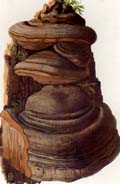
White (sometimes tan to greyish brown), suede-like cuticle that forms inrolled, curb-like sterile margin
On dead or living birch trees
Whiteoporus Tribe

 Key to Gilled Mushrooms Key
Key to Gilled Mushrooms Key Polyporaceae Family
Polyporaceae FamilyPiptoporus Genus White (sometimes tan to greyish brown), suede-like cuticle that forms inrolled, curb-like sterile margin | Links from Look-alikes Whiteoporus Tribe  Sessile cap entirely white to buff |

 Glossary |  Mushrooms |  |  People |  Newsletter |  Events |